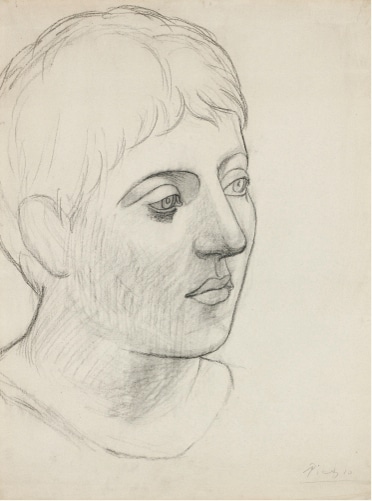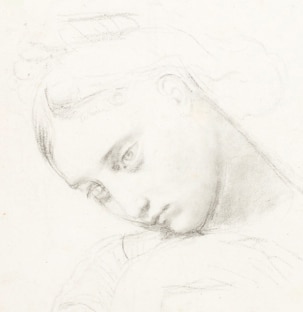This time my “best in show” pick, the 1923 TÊTE DE JEUNE HOMME, is a clear choice, despite the fact that its estimate is more than an order of magnitude lower than the top estimates. The “show” to which I’m referring is this week’s battle between the giants, Christie’s and Sotheby’s. The battlefield is London. As the forces prepare for battle, perhaps you’ve noticed a stalwart young man among them, the Tête de Jeune Homme (Head of a Young Man), a full-sized drawing and a paragon of Picasso’s Neoclassical Period. Picasso created it with black conté crayon, my favorite medium in drawing because of the glistening, bold mark it produces. I must disclose that I haven’t traveled to London to view this drawing in the flesh, nor does its line appear particularly bold or glistening in the catalogue photos. Never mind, even if it were charcoal or pencil, that wouldn’t detract from its magnificence.
On average, I wasn’t all that impressed with the fare from the storied Krugier collection that Christie’s NY presented last fall. Presumably he sold some of his best works over the years, and perhaps his daughter is keeping others for herself. But Sotheby’s, which snagged a far smaller piece of the Krugier action, got this drawing, the best work between both of the houses.
Earlier in the same evening sale is an Ingres drawing, Three Studies for the Figure of Stratonice, of which the following is a detail:
The Ingres is beautiful, but the juxtaposition aptly demonstrates why Ingres will be remembered as a prelude to Picasso. Ingres was a great draftsman, but the profound interest that Picasso’s work inspires is the result not only of Picasso’s draftsmanship–at least Ingres’ equal–but also because of the stylistic complexity of Picasso’s portrait. Picasso’s deceptively simple contour drawing is actually a blend of a fine neoclassical portrait with his own sculptural style, in which by sleight of hand he fashions a two-dimensional artwork seemingly out of solid stone. The off-center placement of the figure is also crucial, as Picasso promotes the negative space upon which the subject’s eyes gaze as a principal part of the composition.

